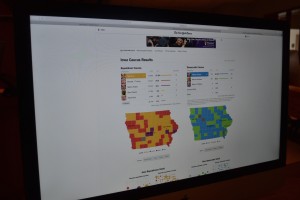Presidential Race 2016: The Iowa Caucuses

The New York Times website showed a vivid image of the results of the Iowa Caucuses. Photo courtesy Ashleigh Stingley
By Ashleigh Stingley
On Feb. 1, the Iowa Caucuses were held in various in Iowa and especially the Winnebago County. Locations for these caucuses in the Forest City area included the Forest City Christian School, Waldorf College and the Forest City High School.
The Iowa Caucuses are the first in the country during the all important Presidential Campaigns. It is through these caucuses the hopeful President Nominees get delegates depending on how the participants vote. It is also rumored these first caucuses have about a 1-in-2 chance of predicating the representative for both of the major parties that run at the end of the elections.
At the end of the night, Hillary Clinton and Bernie Sanders stood almost at a tie for the Democrat delegates while Ted Cruz beat out Donald Trump for the Republication delegates by an almost 3 percent lead. After the caucus, Democrat Martin O’Malley, and Republicans Rand Paul, Carly Fiorina, Mike Huckabee, Chris Christie and Rick Santorum all dropped out of the race.
Both caucuses conduct their processes in two very different matters. The Republicans are more traditional then the Democrat process. Similar to the final election for president in the process, they vote on a poll on who they want to win. This is an advantage as your votes are hidden from other voters, preventing any clashing opinions. While the democrat process is less private, it also has its advantages. Like a polling booth, they ask the caucus participants to stand in a selected area for who they want to give their vote to.
Molly Maschka, a Waldorf senior, went to her first caucus this year. “I really enjoyed it for the first time. Minnesota is not so lucky, as it doesn’t have any caucuses to participate in,” said Maschka. “It was boring at first, but when they finally got into it, it was shown why Iowa was a big one for the caucuses.” Maschka also commented that along with the voting, all of the participants got to read letters from all of the candidates.
When asked who she voted for, Maschka said Sanders. “I like where he stands as far as, say, education. He wants to help those in debt. He wants to get things done and continue what Obama has started,” said Maschka. Maschka also stated that even if Clinton was the Democratic candidate she will still vote for her.
While some nominees were banking on the young adult votes for the Caucus as this is many participants first caucus, there were also definite views from some of the older members. Professor Tiffany Olson didn’t have a chance to go to the caucus. However, she said that if she did she would vote Democratic this year as she is an independent voter.
“There is turmoil in the Republican Party and some of us don’t want to deal with it,” said Olson.
